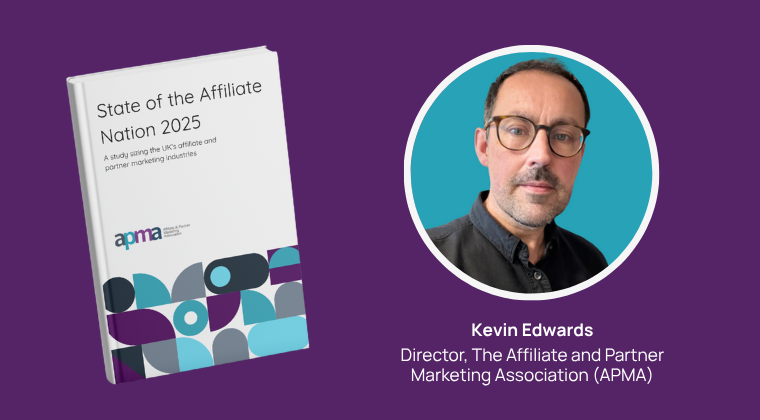A conversation with Kevin Edwards, Director of The Affiliate and Partner Marketing Association (APMA)

In a world where we’re all chronically online, affiliate marketers have turned scrolling into strategy and clicks into commissions. We’ve witnessed the affiliate industry expanding along with the ever-evolving landscape of tech and the digital space – and the APMA have published a report revealing record investment and exceptional performance from one of the UK’s most resilient marketing channels.
The State of the Affiliate Nation 2025 report found that affiliate marketing is growing faster than the UK economy – we sat down with Kevin Edwards, APMA Director to find out why.
When affiliate and partner marketing hit £1.7 billion in the UK last year, it wasn’t just a headline, it was a clear signal. Even in a tough economy, the industry isn’t just surviving. It’s growing. Across sectors, strategies, and tech types, affiliate is evolving fast – and Kevin’s take? “We haven’t lost market share. We’ve been able to hold our own.”
Let’s get into it…
Affiliate growth and where it’s coming from
Compared to the IAB’s latest report showing 13% digital growth overall, affiliate’s 9% might look modest. But digging deeper: “The IAB separates out what they call the big five (which includes Meta, Google, etc.) – and that group grew 15%. Everyone else? 9%. So actually, affiliate marketing is perfectly in line.”
What’s especially interesting is where the growth is coming from. Kevin and his team looked at revenue by affiliate type and found that tech partners (including businesses like intent.ly) are leading the charge. “The third biggest growth area was CSS at 14%, then sub-networks at 18%, and tech partners at 24%. That’s huge.”
Kevin attributes this to the model that tech partners bring to the table. “A business like intent.ly is a one-to-one relationship rather than one-to-many. You’re building individual strategic partnerships – and exponentially scaling them. It’s all new growth and there’s still a tonne of opportunity.”
Retail leads the way, but travel, telco & finance are catching up
With the progression of tech and social media prompting us to be more consumerist than ever, retail dominates the various verticals due to sheer transaction volume. However, Kevin was quick to point out that sectors like travel, telco, and finance are carving out powerful niches. “If you’re in finance or telco, you’re not buying weekly – it might be an annual contract. But that means they have to go out and find growth elsewhere. And actually, they’re more impactful within their categories.”
Travel has bounced back since Covid, and still only accounts for around 15% of affiliate spend but: “We tracked about 10% of retail spend through affiliates, whereas one in every seven pounds in online travel is affiliate-driven. So even though it’s a smaller slice, it’s more meaningful.”
In telco? “You’ve got the big comparison sites – stuff you don’t really get in retail. Plus, the individual payouts are bigger. The proportion of spend going through affiliates in telco is probably higher than retail.”
Tech partners in the spotlight
“Three years ago, 80% of tech partner activity was through one network. But now other networks have invested in tech to allow partners to scale across hundreds of new advertisers.”
Networks are now investing in integrations and product development that make life easier for both tech partners and clients. It’s not just about access, it’s about specialisation. “Tech partners can position themselves as solving a brand’s problem without the brand needing to build their own tech. It’s plug-and-play, with the account management behind it. You’re specialists in the field and always innovating.”
Tech partners highlight the importance of strategic relationship-building and a tailored approach to advertising, as they’ve excelled at creating partnerships from the ground-up, rather than exhausting existing networks.
The most significant changes since the last report?
Voucher codes were a special mention. “I think people will be surprised by the investment in voucher codes. The classification is tricky – if a blogger promotes a code, is it a voucher or a blogger sale? We still see a big chunk of sales coming through voucher codes, but they’re not always accredited back to a voucher code site”.
A new question asked this year was around non-last-click CPA spend, like homepage takeovers and branded emails etc, which Teclo have a big heritage in. “We tracked about £1 in every £7.50 going through non-last click CPA. That’s about £200 million if you scale it up by 9%”. Trying to understand where that’s going will be really interesting to delve into in next year’s report.
What’s next?
Everyone aims to predict the next trend and be ahead of the curve, but Kevin’s not expecting a shake-up in the next 12 months. “People expect some massive new trend. But realistically, it’ll just be continued growth. If we hit 9% again, we’re doing a good job.”
He does expect further growth from tech partners – both in spend and new entrants. “Affiliates are becoming a very easy place for entrepreneurs to gain access to brands pretty quickly.” Kevin noted that CSS (Comparison Shopping Services) may also see more movement, unless Google changes something major, and that it will be interesting to see how the sub-networks evolve over the next 12 months.
We’re looking at a mature and confident affiliate industry. One that’s still innovating, growing, and providing value in a cost-conscious environment. ”Spend grew 9%, but active affiliates only grew about 1%. That means more money is going to existing players – which is good news if you’re one of them.”
______
The State of the Affiliate Nation report, the most comprehensive affiliate industry dataset ever compiled, shows UK brands invested £1.7 billion into affiliate and partner marketing in 2024, a 9% year-on-year increase, producing 360 million sales, and delivering £2.2 million in revenue every hour.
The full 56-page report is available free to APMA members or can be purchased for £550+VAT via The APMA Shop.

Patience is intent.ly’s marketing executive, with a passion for creative content marketing and social media strategies.
